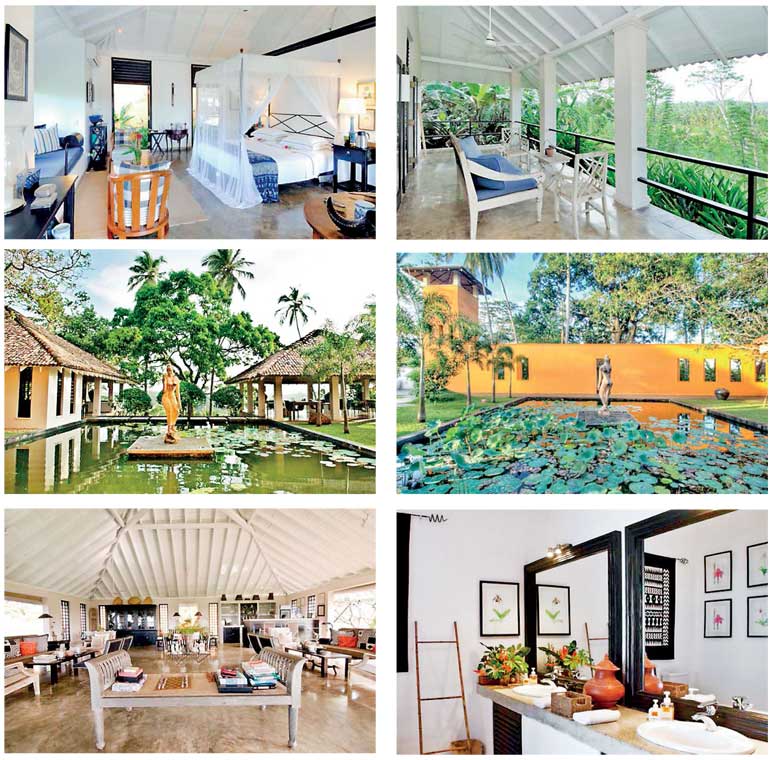Wednesday Mar 12, 2025
Wednesday Mar 12, 2025
Tuesday, 17 November 2015 00:03 - - {{hitsCtrl.values.hits}}
Even the name, which means ‘Yellow Moon Mountain’, hints at the magic to come when guests first ascend the simple stone steps leading to this luxurious retreat. Hidden in the lush green hills outside the Dutch colonial town of Galle and with panoramic views over dense jungle and paddy fields to Koggala Lake beyond, Kahanda Kanda is a tiny slice of paradise, underpinned with a highly original sense of style. For this is no homogenous boutique hotel with an emphasis on a slightly staged colonial or tropical look.
Instead, it is a destination that surprises from the start with an imposing saffron wall slicing dramatically through the property, its door- and window-like openings offering framed vignettes of exotic trees, flowers, shady doorways…
“There’s so much to take in,” explains Kahanda Kanda’s owner, George Cooper, “that the wall is intended to act as a sort of visual guide: It’s a bit like a well-designed garden should be – arranged so that vistas are enjoyed little by little, rather than in one fell swoop.”
A similar treatment has been adopted at the far end of the shimmering infinity pool where a mulberry-coloured wall marks the boundary: both these strong, vivid structures – their colours inspired by the monks’ robes in the south and north of the country, respectively – form an essential framework to the rest of the property, which is, at turns, both contemporary and traditional in its aesthetic.
For British-born George, a renowned interior designer, the creation of Kahanda Kanda came about quite unexpectedly. 16 years ago when he first visited Sri Lanka, intrigued to discover that his ancestors had been tea and rubber planters on the island, he had no intention of buying a property, let alone establishing a hotel. Yet when he found himself on this lofty spot atop a ridge – complete with an unmaintained tea plantation and an ugly 1960s bungalow – he found himself under its spell, and the vision unfolded. By the time he flew back to the UK, he had not only decided to buy the 10-acre plot but had plans to re-establish the tea plantation – a nod to his heritage – and build a property from scratch.

He hired Australian architect Bruce Fell-Smith, who lived on the island, to bring his ideas for a unique retreat to life. The original dwelling was demolished, but in building anew, George was adamant that the beautiful native trees – from coconut to mango and jackfruit – should not be disturbed, hence retaining a verdant, age-old landscape. In terms of the architecture, he sought simple lines and unfussy concepts.
The pair devised a simple footprint: at the heart of the property are the freestanding open-sided Living and Dining pavilions – flanked by lily ponds and manicured lawns, together with the sleek modern pool – while the individual suites or bungalows – there are 10 altogether – are dotted around the property, reached by meandering paths and walkways, all afforded privacy by courtyard gardens or verandas framed by lush vegetation.
The jewel in the crown when it comes to guest quarters is undoubtedly the magnificent Dubu Suite – the antique ‘Joglo’ house from Java was transported back by George, and painstakingly rebuilt on the grounds: traditional woven palm walls, an intricately carved ceiling, and a series of louvered doors leading to a wrap-around veranda form its bones, with outdoor sunken baths on either side.
Not surprisingly, George’s design talents have come to the fore in the interiors. All the rooms and pavilions benefit from his unerring eye for detail and his ability to put together what could so easily be a disparate muddle into schemes of harmony and grace. English classics, from oak bureaus and plump sofas to porcelain and artwork – with many items shipped from George’s family home – blend comfortably with Asian antiques, locally made furniture and textiles, together with furnishings, objects and fabrics from India and Indonesia. The floors are polished concrete, the bathrooms sleek and modern, the four-poster beds dressed with crisp linen and swathed in mosquito nets.
This is a place that delights the eye and engages the senses on every level – inducing a feeling of wellbeing and serenity. It’s the very reason why George fell in love with this hilltop paradise in the first place. There is indeed magic to be discovered at Kahanda Kanda. (Source: http://insideoutmagazine.ae)
Discover Kapruka, the leading online shopping platform in Sri Lanka, where you can conveniently send Gifts and Flowers to your loved ones for any event including Valentine ’s Day. Explore a wide range of popular Shopping Categories on Kapruka, including Toys, Groceries, Electronics, Birthday Cakes, Fruits, Chocolates, Flower Bouquets, Clothing, Watches, Lingerie, Gift Sets and Jewellery. Also if you’re interested in selling with Kapruka, Partner Central by Kapruka is the best solution to start with. Moreover, through Kapruka Global Shop, you can also enjoy the convenience of purchasing products from renowned platforms like Amazon and eBay and have them delivered to Sri Lanka.
Discover Kapruka, the leading online shopping platform in Sri Lanka, where you can conveniently send Gifts and Flowers to your loved ones for any event including Valentine ’s Day. Explore a wide range of popular Shopping Categories on Kapruka, including Toys, Groceries, Electronics, Birthday Cakes, Fruits, Chocolates, Flower Bouquets, Clothing, Watches, Lingerie, Gift Sets and Jewellery. Also if you’re interested in selling with Kapruka, Partner Central by Kapruka is the best solution to start with. Moreover, through Kapruka Global Shop, you can also enjoy the convenience of purchasing products from renowned platforms like Amazon and eBay and have them delivered to Sri Lanka.